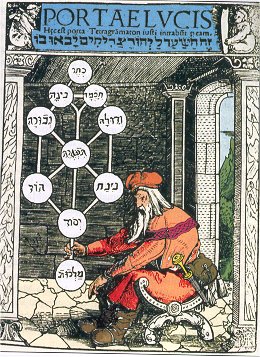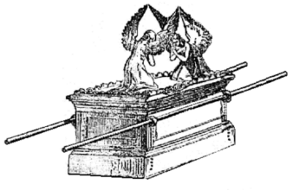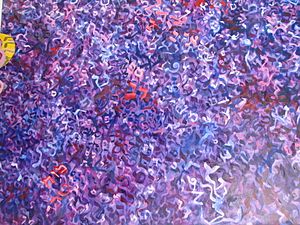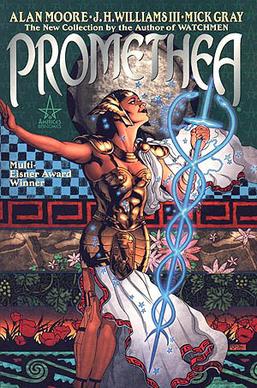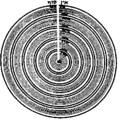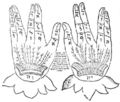Kabbalah facts for kids
Kabbalah is a special way of understanding the Torah (the Hebrew Bible). It's a mystical part of Judaism that tries to explain God's nature. It began around the 1st century with Rabbi Simeon bar Yochai. Later, in the 13th century, Rabbi Moses de León helped it grow in Spain.
Kabbalah tries to explain how things that are hard to imagine, like God, can still be understood and felt. It has greatly influenced Jewish spiritual life. It includes beliefs about God, how God created the universe, and the laws of nature. It also offers a path for religious Jews to learn these deep secrets.
Kabbalah helps explain the reasons behind the commandments in the Torah. It also helps understand why events in the Torah happened. It teaches about the spiritual levels of creation and how God manages the universe. A key idea in Kabbalah is the "Tree of Life," which shows 10 special powers called Sephirot. These powers affect different parts of the world.
Jewish tradition says this knowledge was given to special holy people long ago. It was kept secret by only a few. It is considered part of the Jewish Oral Law.
What is Jewish Mysticism?
Followers of Kabbalah believe its ideas come from the Tanakh (the Hebrew Bible). When a Kabbalist reads the Torah's story of creation in the Book of Genesis, they find hidden meanings. These meanings are about God creating the universe, Adam and Eve, the Garden of Eden, the Tree of Knowledge of Good and Evil, and a Tree of Life. They also explain the interaction with the Serpent that led to eating the forbidden fruit.
Many stories in the Tanakh show mystical experiences. Jacob's vision of a ladder to heaven is one example. Moses' experience with the Burning Bush and his talks with God on Mount Sinai are others. The prophet Ezekiel also had powerful visions. These events are seen as the start of Jewish mystical beliefs.
During the medieval era, Jewish mysticism grew a lot. This was helped by a mystical text called the Sefer Yetzirah. Jewish sources say this book was written by the biblical leader Abraham. This book became a main focus for special students called baale ha-kabbalah, meaning "masters of the Kabbalah."
Kabbalah teaches that every Hebrew letter, word, number, and accent in the Hebrew Bible has a hidden meaning. It also teaches ways to understand these secret meanings.
Kabbalistic writings try to answer a big question: If God is good and powerful, why is there evil in the world? This is called a theodicy. Kabbalah uses the Tree of Life to explain this in different ways.
Kabbalah Today
A modern interest in Kabbalah began with the Kabbalah Center. It was started by Philip Berg in Los Angeles in 1984. This group has branches around the world. It has attracted many non-Jews, including famous people like Madonna, Demi Moore, Mick Jagger, and Britney Spears.
Kabbalah in Stories
The anime series Neon Genesis Evangelion uses many Kabbalah images. It suggests that a secret part of Kabbalah was hidden in the Dead Sea scrolls. This knowledge was then kept safe by different people over time. For example, the Systema Sephiroticum (which is like the Tree of Life) appears in characters' offices. In the movie End of Evangelion, during a big event called the "Third Impact," the Tree of Life is shown a lot. Characters even seem to "walk through" its explanation of what is happening.
The comic series Promethea by Alan Moore also uses Kabbalah ideas a lot. The series is largely a way to explain many Kabbalistic concepts. The main character travels up through the entire Tree of Life. Over many issues, she explores the symbols and meanings of each level and of her journey itself.
Images for kids
-
Kabbalistic prayer book from Italy, 1803. Jewish Museum of Switzerland, Basel.
-
The Ark of the Covenant in Solomon's Temple was the seat for God's presence. Ezekiel and Isaiah had prophetic visions of the angelic heavenly Chariot and Divine Throne
-
Grave of Rabbi Akiva in Tiberias. He features in Hekhalot mystical literature, and as one of the four who entered the Pardes
-
The 13th-century eminence of Nachmanides, a classic rabbinic figure, gave Kabbalah mainstream acceptance through his Torah commentary
-
The leading scholars of Safed in 16th-century invigorated mainstream Judaism through new legal, liturgical, exegetical and Lurianic-mythological developments.
-
The 16th-century Maharal of Prague articulated a mystical exegesis in philosophical language
-
Moshe Chaim Luzzatto, a leading Italian kabbalist, also wrote secular works, which the Haskalah see as the start of modern Hebrew literature
-
The Vilna Gaon, 18th-century leader of rabbinic opposition to Hasidism—a Kabbalist who opposed Hasidic doctrinal and practical innovations
-
Synagogue of the Baal Shem Tov, founder of Hasidism, in Medzhybizh (Ukraine). It gave a new phase to Jewish mysticism, seeking its popularisation through internal correspondence.
-
The Kabbalist (c. 1910–1920), portrait of an Hasidic man in Jewish religious clothing performed by the Austro-Hungarian Jewish painter Isidor Kaufmann (Jewish Museum, New York)
-
Amulet from the 15th century. Theosophical kabbalists, especially Luria, censored contemporary Practical Kabbalah, but allowed amulets by Sages
-
Joseph Karo's role as both legalist and mystic underscores Kabbalah's spiritualisation of normative Jewish observance
-
Title page of first printed edition of the Zohar, main sourcebook of Kabbalah, from Mantua, Italy in 1558
-
Golden age of Spanish Judaism on the Knesset Menorah, Maimonides holding Aristotle's work
-
Kabbalah mysticism on the Knesset Menorah, which shared some similarities of theory with Jewish Neoplatonists
-
Tikkun for reading through the night of Shavuot, a popular Jewish custom from the Safed Kabbalists
-
A version of Lekhah Dodi song to welcome the Shabbat, a cross denomination Jewish custom from Kabbalah
See also
 In Spanish: Cábala para niños
In Spanish: Cábala para niños


